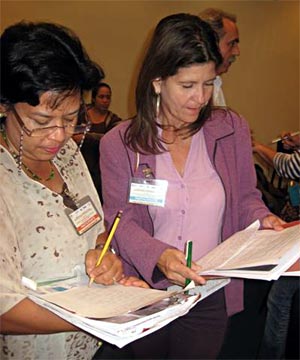
 Experts from around the Americas met in Venezuela to share experiences, information and tools to improve the health and safety of health workers in the Region. Health care jobs are among the most hazardous, along with jobs in agriculture and construction, because of exposition to a variety of biological, chemical, physical, and psychosocial hazards.
Experts from around the Americas met in Venezuela to share experiences, information and tools to improve the health and safety of health workers in the Region. Health care jobs are among the most hazardous, along with jobs in agriculture and construction, because of exposition to a variety of biological, chemical, physical, and psychosocial hazards.
First Regional Meeting for Latin America and Caribbean on Health Protection for Health-Care Workers
September 22nd-24th, 2009
Maracay, Venezuela
On September 22nd-24th, 2009, PAHO/WHO, in collaboration with the Ministry of Health of Venezuela, the "Instituto de Altos Estudios de Salud Dr.Arnoldo Gabaldon", and the U.S. National Institute for Occupational Safety and Health (NIOSH) organized the First Regional Meeting for Latin America and Caribbean on Health Protection for Health-Care Workers.
Several other collaborators contributed, on different levels, to this event—including ministries of heath from across the region, Nescon (Núcleo de Estudos em Saúde Coletiva, Federal University of Minas Gerais, Brazil), the University of British Columbia, the International Healthcare Workers Safety Center from the University of Virginia, the government of Canada, Public Services International, as well as non governmental organizations such as the Training for Development of Innovative Control Technologies Project, the Proyecto Risco biológico.org, and the International Commission on Occupational Health and Safety.
The event brought together policymakers, academics, hospital managers, epidemiologists, front line workers, and civil society from across the region to work towards improving the health and safety of healthcare workers. In total, over 200 participants, including more than 20 international attendees from Brazil, Canada, Colombia, Costa Rica, Cuba, Ecuador, Guyana, Panama, Peru, United States, and Trinidad and Tobago participated in this important event.

At the meeting, participants completed an exercise on the evaluation of safety medical devices.
The First Regional Meeting for Latin America and Caribbean on Health Protection for Health-Care Workers included special sessions focusing on occupational health policies and programs in the health sector; occupational surveillance system; and on the evaluation of safety medical devices. All sessions were especially focusing on the prevention of occupational transmission of infectious diseases among healthcare workers. During the policies and programs session, participants exchanged best practices and resources for protecting and promoting the health and safety of healthcare workers. For example, the presenters shared tools to strengthen health and safety committees, as well as information on the organization of immunization campaigns targeting healthcare workers.
During the session on surveillance systems, the participants had the opportunity to gain hands-on experience on EPINet, a surveillance system for tracking needlestick injures and blood and body fluid exposure among healthcare workers. This surveillance system, which led to development of new occupational health policy, can be accessed free of charge, is available in 17 languages, and is now used in over 50 countries. The session on the evaluation of safety engineered devices aims to enable countries to select appropriate medical devices. The new generation of safe-engineered medical devices, such as blunt needle or retractable needle, has contributed to a significant decrease of work-related injuries. Preventing work-related hazards directly at the source is a major priority to reduce the occupational transmission of infectious diseases caused by needlestick/sharps injuries.
This activity is part of the PAHO Regional Plan of Action on Workers' health, the PAHO Regional Plan on Human resources for health, and the WHO Global Plan of Action on Workers' health. PAHO is aiming to continue working with PAHO/WHO Collaborating Centers in Occupational Health and other key partners toward the improvement of the health, safety, and working condition of healthcare workers.



